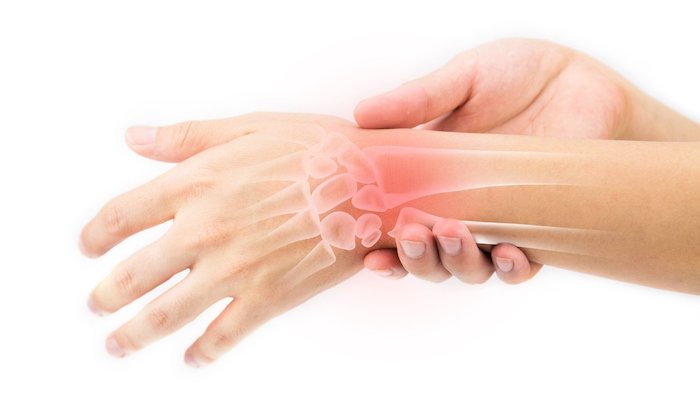
Do you text or type? If so, you’re vulnerable to wrist pain. Any sports, job, hobby, or daily activity that requires repetitive wrist movement increases your risk of painful wrist problems. You could also fall and try to catch yourself, landing on an outstretched arm and injuring your wrist.
Wrist Sprains
Sprains occur when a ligament is stretched or torn. When the sprain occurs in your wrist, it’s often because of repetitive movement or any strong impact that bends or twists the wrist.
In addition to wrist pain, a sprain causes symptoms such as swelling and bruising. If the nearby nerves are pinched, you may also experience burning or tingling sensations.
Wrist Tendonitis
Multiple tendons go through your wrist, connecting your arm muscles to finger and hand bones. Tendonitis occurs when these structures become inflamed. Golf, tennis, typing, and working with machinery are a few of the most common causes of wrist tendonitis.
One type of wrist tendonitis, DeQuervain’s syndrome, is caused by inflammation in the tendon that attaches your forearm to your thumb. New parents often develop DeQuervain’s as they suddenly spend a lot of time holding and caring for their baby. But it can also be brought on by activities such as texting, golfing, skiing, hammering, and knitting.
Wrist tendonitis is known for causing dull, aching pain and stiffness. By comparison, DeQuervain’s often results in severe pain that makes it hard to use your hand.
Ganglion Cysts
Ganglion cysts usually develop on the top of your wrist, but they can also appear on the underside. These cysts appear over a wrist joint or tendon when synovial membranes are injured. As a result, a cyst or sac develops that’s filled with thick, synovial fluid.
Large ganglion cysts cause bulging and painful lumps. A ganglion cyst may affect your ability to move your wrist and hand. It can also press on a nerve and cause hand weakness.
Arthritis
Your wrist is made up of multiple joints, and any of them can develop one of three types of arthritis, osteoarthritis, rheumatoid arthritis, or post-traumatic arthritis.
Osteoarthritis occurs when the cartilage that covers the ends of bones breaks down and wears away. As a result, the bones can’t glide smoothly. Instead, bone rubs against bone, causing further joint damage.
Rheumatoid arthritis develops when your immune system attacks membranes that line the joints, causing inflammation that leads to progressive damage and deformities.
Post-traumatic arthritis is a type of osteoarthritis that develops more rapidly than osteoarthritis caused by daily wear and tear.
All types of arthritis cause wrist pain, inflammation, stiffness, and limited movement.
Wrist Fractures
Sports injuries and falls are the top causes of wrist fractures. A broken wrist, called a distal radius fracture, occurs when your largest arm bone breaks at the wrist. In some cases, the damage can extend into the wrist joint.
The second type of wrist fracture, called a scaphoid fracture, occurs in one of the small wrist bones near your thumb.
A broken wrist causes pain, swelling, bruising, tenderness, and limited movement. You feel the pain of a scaphoid fracture below the base of your thumb.
Carpal Tunnel Syndrome
Carpal tunnel syndrome originates in your wrist when one of the nerves, the median nerve, is pinched as it travels through a small opening called the carpal tunnel.
You can end up with carpal tunnel syndrome after a wrist injury, when tendons going through the carpal tunnel become inflamed or when the nerve is irritated.
Any activity that bends your wrist up or down, or performing stationary activities like typing with your wrists arched, can cause carpal tunnel syndrome.
In addition to wrist pain, carpal tunnel syndrome causes tingling or numbness in your fingers and hand, and it can give you a weak grip.
Precision Pain Care and Rehabilitation has two convenient locations in Richmond Hill – Queens and New Hyde Park – Long Island. Call the Queens office at (718) 215-1888, or (516) 419-4480 for the Long Island office, to arrange an appointment with our Interventional Pain Management Specialist, Dr. Jeffrey Chacko.













